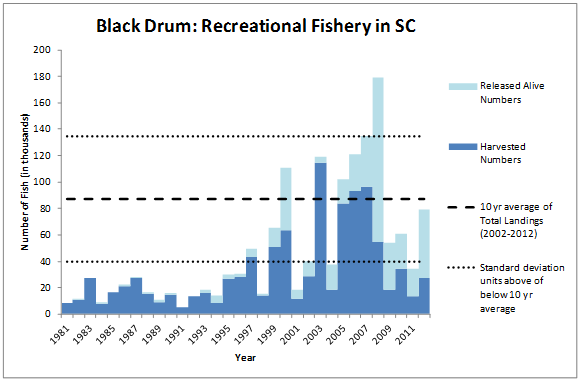Marine - Species - Black Drum
Recreational Fishery in SC

Total catch for black drum experienced a steadily increasing trend beginning in 1995 and peaking in 2008, after which it declined to levels below the 10 year average. Prior to 1995, annual catch remained relatively consistent but low. Peak years occurred in 2000, 2003 and 2006-2008 and likely reflect several strong year-classes that occurred in 1999 and the early 2000’s. The 10 year average landings (2002-2012) was relatively high, compared to most years, due to the high level of annual catches during this time period. In August of 2007 South Carolina implemented a new slot size limit (14-27 inches) and bag limit (5 fish per day per person) on black drum. The decrease in total catch as well as the increase in the numbers of black drum released alive was likely due, at least in part, to the new management regulations.
While South Carolina has had limited commercial fishing for black drum, peak landings occurred in the 1950's and 1960's and there have been no reported commercial landings since 1992. South Carolina has only reported commercial landings in 35 of the last 62 years (1950-2012).
The recreational catch data is provided by the National Marine Fisheries Service (NMFS), which conducts phone and angler-intercept surveys to monitor angler activities and catches. For more information see: https://www.st.nmfs.noaa.gov/.
The commercial fisheries data is provided by the National Marine Fisheries Service (NMFS), which compiles commercial information provided by state agencies. For more information, see: https://www.st.nmfs.noaa.gov/.
Additional Graph Information
Commercial and recreational catches are measured in number of individuals or pounds of fish caught. Changes in catch among years may be the result of changes in abundance, fishing effort, or a combination of the two.
On each graph, the horizontal dotted lines above or below the "10 year average" represent one "standard deviation" unit, which is a measure of how variable the annual data are around the 10-year average. In general, the area between one standard deviation above the mean and one standard deviation below the mean includes approximately 68% of all values. Approximately 95% of observations in the data set are found within two standard deviation units of the average and is referred to as the prediction interval.
